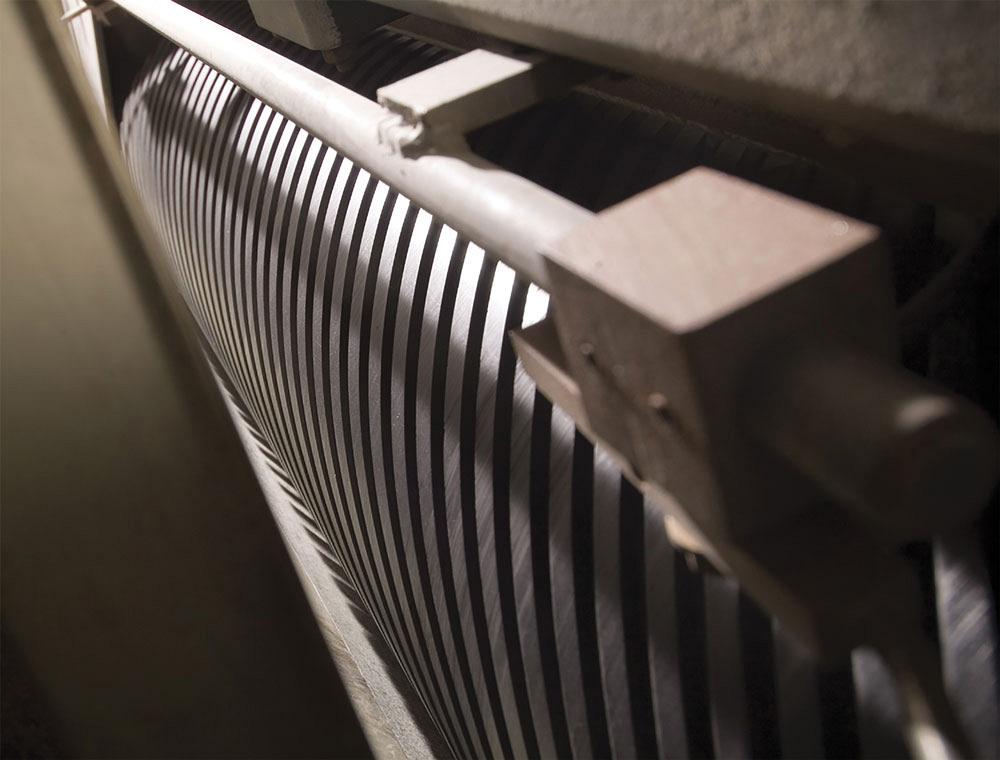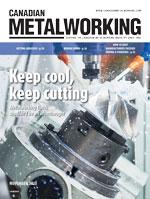Senior Application Engineer
- FMA
- The Fabricator
- FABTECH
- Canadian Metalworking
Tips for choosing abrasive belt contact wheels and rolls
Getting abrasive
- By Douglas P. Jensen
- December 1, 2020
- Article
- Metalworking

Next-generation SG ceramic alumina grain belts are suitable for processing mild and carbon steel, stainless, cobalt, chrome, INCONEL, and titanium.
Most abrasive belt applications use either a contact wheel or roll, which supplies support for the coated abrasive belts during operation.
Typically, contact wheels are used with abrasive belts that are less than 15 in. wide (narrow belts), while contact rolls are used with abrasive belts that are 15 in. or wider (wide belts).
Common contact wheel diameters are from approximately 0.25 in. up to 16 in. or greater and can have widths from 0.25 in. up to any width less than 15 in. Common contact roll diameters are from about 5 in. up to 20 in. or greater and have widths from 15 in. up to 130 in. or wider.
Equipment Factors
The most significant differences between contact wheels and rolls is the equipment they are used on.
Equipment using contact wheels generally have a crowned idler or drive wheel to track the position of the abrasive belt during use. When the idler or drive wheel is crowned correctly and is in good working order, the centre of the abrasive belt will position itself on the centre (highest point) of the wheel with very little side-to-side belt movement.
Because contact rolls are wider, it is not plausible to use this same method for abrasive belt tracking purposes. Instead, equipment using contact rolls typically track abrasive belts by continuously oscillating the belt tensioning roll, or idler roll. When the tracking/tensioning roll oscillates to the right or left, a temporary high spot is created on one side of the roll that the abrasive belts ride up on.
Electronic “eyes” are used to detect the edge of the abrasive belt as it approaches the end of the roll. This triggers a mechanism to oscillate the roll in the opposite direction, which the abrasive belt then follows because of the temporary high spot moving to the opposite side of the roll. This process repeats itself constantly while the equipment is in use.
It should be noted that the oscillation on wide-belt equipment with a contact roll should be no more than 25 cycles per minute and the side-to-side movement of the abrasive belt should be relatively balanced. This creates a slow, methodical movement of the abrasive belt, which is all that is needed.
Because most of this type of equipment uses pneumatics to complete this task, any unneeded movement of these rolls causes unnecessary consumption of compressed air and can also create excessive tracking component part wear.
Additionally, faster oscillation and uneven balance of the side-to-side movement of the belt will cause the abrasive belt to track off of the equipment and cause damage. It even can fold over on itself during the tracking/oscillation process. Both scenarios result in an unusable abrasive belt.

The oscillation on wide-belt equipment with a contact roll should be no more than 25 cycles per minute and the side-to-side movement of the abrasive belt should be relatively balanced.
Consider the Design
Generally speaking, whether they are used for narrow- or wide-belt applications, contact wheels and rolls perform the same function, so their designs are typically similar to one another.
With coarse-grit-size belts used for heavy material removal applications, the wheels and rolls typically are made of steel or hard rubber (durometer: 85 to 95 Shore A). For middle grit sizes and relatively low material removal applications, they typically are moderately hard rubber (durometer: 65 to 75 Shore A). On finer grit sizes for finish upgrade and final finish applications, they typically are moderately soft rubber (durometer: 45 to 55 Shore A).
In all cases they can have various land-to-groove ratios1 or can be smooth-faced.
Hundreds of coated abrasive applications use these most common contact wheel or roll designs. However, wheel designs for narrow-belt applications have a much broader scope because of the many different parameters within the applications they are used for. These applications include thousands of different component part shapes and material types.
Within these examples, many coated abrasive narrow-belt applications use conventional contact wheels, but there are also numerous custom-built or improvised contact wheels made from a variety of materials. These include cloth buffing wheels, pleated rubber, shaped rubber, non-woven and flap wheels (designed to be used independently for weld blending, burr removal, polishing, graining, and other applications), and composites.
Know the Application Requirements
Considering the vast array of coated abrasive belt applications and the availability of many different contact wheels and roll designs, one might think that it would be a relatively easy task to match up these two items for the best performance and functionality.
But that is not always the case, especially for new applications in which the actual material removal requirements are not absolute.
Often new machine designs are based on the expected grinding or polishing needs for new parts that have not reached their final design stage. When the part's final design is complete and it’s ready for production on the new equipment, the part could have significantly tighter tolerances than expected, so the contact wheels and abrasive belts chosen may be too aggressive for the application.
On the other hand, the part tolerance could be significantly looser than expected and the contact wheel and abrasive belt chosen could be less aggressive than required. These situations are not common but have the potential to disrupt the production ramp-up of a new product until appropriate contact wheel and coated abrasive belt modifications can be made.
Knowing the actual application requirements is imperative for selecting the correct contact wheel, along with the correct coated abrasive belt, for an application.
Note
The land-to-groove ratio is a comparison of the widths of the lands, which make contact with the back of the abrasive belt, with neighbouring grooves that have been cut into the contact wheel or roll face at specific angles.
For example:
- If the land is 0.5 in. wide and the groove is 0.5 in. wide, it has a 1-1 ratio.
- If the land is 0.5 in. wide and the groove is 0.25 in. wide, it has a 2-1 ratio.
- If the land is 0.25 in. wide and the groove is 0.5 in. wide, it has a 1-2 ratio.
Douglas P. Jensen is senior application engineer, Norton│Saint-Gobain Abrasives, 1 New Bond St., Worcester, Mass. 01606, 254-918-2313, www.nortonabrasives.com.
About the Author
Related Companies
subscribe now


Keep up to date with the latest news, events, and technology for all things metal from our pair of monthly magazines written specifically for Canadian manufacturers!
Start Your Free Subscription- Trending Articles
Automating additive manufacturing

Sustainability Analyzer Tool helps users measure and reduce carbon footprint

CTMA launches another round of Career-Ready program

Sandvik Coromant hosts workforce development event empowering young women in manufacturing

GF Machining Solutions names managing director and head of market region North and Central Americas

- Industry Events
MME Winnipeg
- April 30, 2024
- Winnipeg, ON Canada
CTMA Economic Uncertainty: Helping You Navigate Windsor Seminar
- April 30, 2024
- Windsor, ON Canada
CTMA Economic Uncertainty: Helping You Navigate Kitchener Seminar
- May 2, 2024
- Kitchener, ON Canada
Automate 2024
- May 6 - 9, 2024
- Chicago, IL
ANCA Open House
- May 7 - 8, 2024
- Wixom, MI















